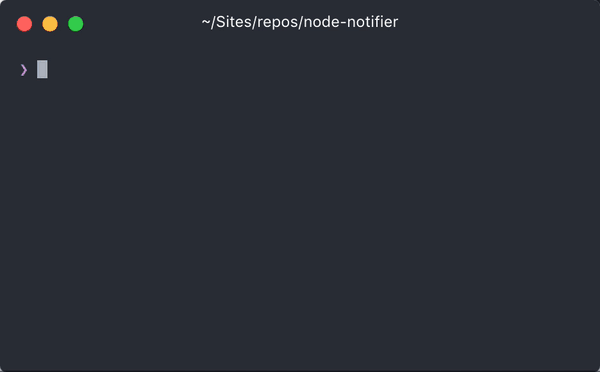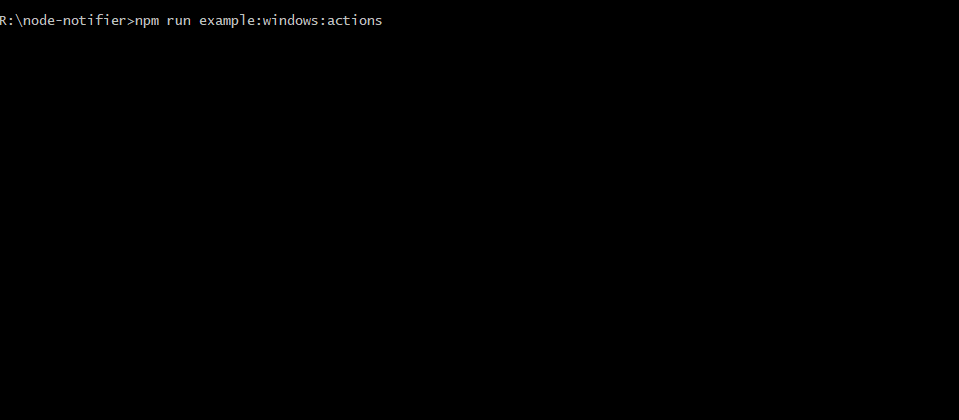node-notifier 


Send cross platform native notifications using Node.js. Notification Center for macOS,
notify-osd/libnotify-bin for Linux, Toasters for Windows 8/10, or taskbar balloons for
earlier Windows versions. Growl is used if none of these requirements are met.
Works well with Electron.
Input Example macOS Notification Center
Actions Example Windows SnoreToast
Quick Usage
Show a native notification on macOS, Windows, Linux:
const notifier = require('node-notifier');
// String
notifier.notify('Message');
// Object
notifier.notify({
title: 'My notification',
message: 'Hello, there!'
});Requirements
- macOS: >= 10.8 for native notifications, or Growl if earlier.
-
Linux:
notify-osdorlibnotify-bininstalled (Ubuntu should have this by default) - Windows: >= 8, or task bar balloons for Windows < 8. Growl as fallback. Growl takes precedence over Windows balloons.
- General Fallback: Growl
See documentation and flow chart for reporter choice.
Install
npm install --save node-notifierCLI
CLI has moved to separate project: https://github.com/mikaelbr/node-notifier-cli
Cross-Platform Advanced Usage
Standard usage, with cross-platform fallbacks as defined in the reporter flow chart. All of the options below will work in some way or another on most platforms.
const notifier = require('node-notifier');
const path = require('path');
notifier.notify(
{
title: 'My awesome title',
message: 'Hello from node, Mr. User!',
icon: path.join(__dirname, 'coulson.jpg'), // Absolute path (doesn't work on balloons)
sound: true, // Only Notification Center or Windows Toasters
wait: true // Wait with callback, until user action is taken against notification, does not apply to Windows Toasters as they always wait or notify-send as it does not support the wait option
},
function (err, response, metadata) {
// Response is response from notification
// Metadata contains activationType, activationAt, deliveredAt
}
);
notifier.on('click', function (notifierObject, options, event) {
// Triggers if `wait: true` and user clicks notification
});
notifier.on('timeout', function (notifierObject, options) {
// Triggers if `wait: true` and notification closes
});If you want super fine-grained control, you can customize each reporter individually, allowing you to tune specific options for different systems.
See below for documentation on each reporter.
Example:
const NotificationCenter = require('node-notifier/notifiers/notificationcenter');
new NotificationCenter(options).notify();
const NotifySend = require('node-notifier/notifiers/notifysend');
new NotifySend(options).notify();
const WindowsToaster = require('node-notifier/notifiers/toaster');
new WindowsToaster(options).notify();
const Growl = require('node-notifier/notifiers/growl');
new Growl(options).notify();
const WindowsBalloon = require('node-notifier/notifiers/balloon');
new WindowsBalloon(options).notify();Or, if you are using several reporters (or you're lazy):
// NOTE: Technically, this takes longer to require
const nn = require('node-notifier');
new nn.NotificationCenter(options).notify();
new nn.NotifySend(options).notify();
new nn.WindowsToaster(options).notify(options);
new nn.WindowsBalloon(options).notify(options);
new nn.Growl(options).notify(options);Contents
- Notification Center documentation
- Windows Toaster documentation
- Windows Balloon documentation
- Growl documentation
- Notify-send documentation
Usage: NotificationCenter
Same usage and parameter setup as terminal-notifier.
Native Notification Center requires macOS version 10.8 or higher. If you have an earlier version, Growl will be the fallback. If Growl isn't installed, an error will be returned in the callback.
Example
Because node-notifier wraps around terminal-notifier,
you can do anything terminal-notifier can, just by passing properties to the notify
method.
For example:
- if
terminal-notifiersays-message, you can do{message: 'Foo'} - if
terminal-notifiersays-list ALL, you can do{list: 'ALL'}.
Notification is the primary focus of this module, so listing and activating do work, but they aren't documented.
All notification options with their defaults:
const NotificationCenter = require('node-notifier').NotificationCenter;
var notifier = new NotificationCenter({
withFallback: false, // Use Growl Fallback if <= 10.8
customPath: undefined // Relative/Absolute path to binary if you want to use your own fork of terminal-notifier
});
notifier.notify(
{
title: undefined,
subtitle: undefined,
message: undefined,
sound: false, // Case Sensitive string for location of sound file, or use one of macOS' native sounds (see below)
icon: 'Terminal Icon', // Absolute Path to Triggering Icon
contentImage: undefined, // Absolute Path to Attached Image (Content Image)
open: undefined, // URL to open on Click
wait: false, // Wait for User Action against Notification or times out. Same as timeout = 5 seconds
// New in latest version. See `example/macInput.js` for usage
timeout: 5, // Takes precedence over wait if both are defined.
closeLabel: undefined, // String. Label for cancel button
actions: undefined, // String | Array<String>. Action label or list of labels in case of dropdown
dropdownLabel: undefined, // String. Label to be used if multiple actions
reply: false // Boolean. If notification should take input. Value passed as third argument in callback and event emitter.
},
function (error, response, metadata) {
console.log(response, metadata);
}
);Note: The wait option is shorthand for timeout: 5. This just sets a timeout
for 5 seconds. It does not make the notification sticky!
As of Version 6.0 there is a default timeout set of 10 to ensure that the application closes properly. In order to remove the timeout and have an instantly closing notification (does not support actions), set timeout to false. If you are using action it is recommended to set timeout to a high value to ensure the user has time to respond.
Exception: If reply is defined, it's recommended to set timeout to a either
high value, or to nothing at all.
For macOS notifications: icon, contentImage, and all forms of reply/actions require macOS 10.9.
Sound can be one of these: Basso, Blow, Bottle, Frog, Funk, Glass,
Hero, Morse, Ping, Pop, Purr, Sosumi, Submarine, Tink.
If sound is simply true, Bottle is used.
See Also:
Custom Path clarification
customPath takes a value of a relative or absolute path to the binary of your
fork/custom version of terminal-notifier.
Example: ./vendor/mac.noindex/terminal-notifier.app/Contents/MacOS/terminal-notifier
Spotlight clarification
terminal-notifier.app resides in a mac.noindex folder to prevent Spotlight from indexing the app.
Usage: WindowsToaster
Note: There are some limitations for images in native Windows 8 notifications:
- The image must be a PNG image
- The image must be smaller than 1024×1024 px
- The image must be less than 200kb
- The image must be specified using an absolute path
These limitations are due to the Toast notification system. A good tip is to use
something like path.join or path.delimiter to keep your paths cross-platform.
From mikaelbr/gulp-notify#90 (comment)
You can make it work by going to System > Notifications & Actions. The 'toast' app needs to have Banners enabled. (You can activate banners by clicking on the 'toast' app and setting the 'Show notification banners' to On)
Windows 10 Fall Creators Update (Version 1709) Note:
Snoretoast is used to get native Windows Toasts!
The default behaviour is to have the underlying toaster applicaton as appID.
This works as expected, but shows SnoreToast as text in the notification.
With the Fall Creators Update, Notifications on Windows 10 will only work as
expected if a valid appID is specified. Your appID must be exactly the same
value that was registered during the installation of your app.
You can find the ID of your App by searching the registry for the appID you
specified at installation of your app. For example: If you use the squirrel
framework, your appID will be something like com.squirrel.your.app.
const WindowsToaster = require('node-notifier').WindowsToaster;
var notifier = new WindowsToaster({
withFallback: false, // Fallback to Growl or Balloons?
customPath: undefined // Relative/Absolute path if you want to use your fork of SnoreToast.exe
});
notifier.notify(
{
title: undefined, // String. Required
message: undefined, // String. Required if remove is not defined
icon: undefined, // String. Absolute path to Icon
sound: false, // Bool | String (as defined by http://msdn.microsoft.com/en-us/library/windows/apps/hh761492.aspx)
id: undefined, // Number. ID to use for closing notification.
appID: undefined, // String. App.ID and app Name. Defaults to no value, causing SnoreToast text to be visible.
remove: undefined, // Number. Refer to previously created notification to close.
install: undefined // String (path, application, app id). Creates a shortcut <path> in the start menu which point to the executable <application>, appID used for the notifications.
},
function (error, response) {
console.log(response);
}
);
Usage: Growl
const Growl = require('node-notifier').Growl;
var notifier = new Growl({
name: 'Growl Name Used', // Defaults as 'Node'
host: 'localhost',
port: 23053
});
notifier.notify({
title: 'Foo',
message: 'Hello World',
icon: fs.readFileSync(__dirname + '/coulson.jpg'),
wait: false, // Wait for User Action against Notification
// and other growl options like sticky etc.
sticky: false,
label: undefined,
priority: undefined
});See more information about using growly.
Usage: WindowsBalloon
For earlier versions of Windows, taskbar balloons are used (unless
fallback is activated and Growl is running). The balloons notifier uses a great
project called notifu.
const WindowsBalloon = require('node-notifier').WindowsBalloon;
var notifier = new WindowsBalloon({
withFallback: false, // Try Windows Toast and Growl first?
customPath: undefined // Relative/Absolute path if you want to use your fork of notifu
});
notifier.notify(
{
title: undefined,
message: undefined,
sound: false, // true | false.
time: 5000, // How long to show balloon in ms
wait: false, // Wait for User Action against Notification
type: 'info' // The notification type : info | warn | error
},
function (error, response) {
console.log(response);
}
);See full usage on the project homepage: notifu.
Usage: NotifySend
Note: notify-send doesn't support the wait flag.
const NotifySend = require('node-notifier').NotifySend;
var notifier = new NotifySend();
notifier.notify({
title: 'Foo',
message: 'Hello World',
icon: __dirname + '/coulson.jpg',
wait: false, // Defaults no expire time set. If true expire time of 5 seconds is used
timeout: 10, // Alias for expire-time, time etc. Time before notify-send expires. Defaults to 10 seconds.
// .. and other notify-send flags:
'app-name': 'node-notifier',
urgency: undefined,
category: undefined,
hint: undefined
});See flags and options on the man page notify-send(1)
Thanks to OSS
node-notifier is made possible through Open Source Software.
A very special thanks to all the modules node-notifier uses.
Common Issues
Windows: SnoreToast text
See note on "Windows 10 Fall Creators Update" in Windows section.
Short answer: update your appID.
Windows and WSL2
If you don't see notifications within WSL2, you might have to change permission of exe vendor files (snoreToast). See issue for more info
Use inside tmux session
When using node-notifier within a tmux session, it can cause a hang in the system.
This can be solved by following the steps described in this comment
There’s even more info here https://github.com/mikaelbr/node-notifier/issues/61#issuecomment-163560801.
macOS: Custom icon without Terminal icon
Even if you define an icon in the configuration object for node-notifier, you will
see a small Terminal icon in the notification (see the example at the top of this
document).
This is the way notifications on macOS work. They always show the icon of the
parent application initiating the notification. For node-notifier, terminal-notifier
is the initiator, and it has the Terminal icon defined as its icon.
To define your custom icon, you need to fork terminal-notifier and build your
custom version with your icon.
See Issue #71 for more info https://github.com/mikaelbr/node-notifier/issues/71.
Within Electron Packaging
If packaging your Electron app as an asar, you will find node-notifier will fail to load.
Due to the way asar works, you cannot execute a binary from within an asar.
As a simple solution, when packaging the app into an asar please make sure you
--unpack the vendor/ folder of node-notifier, so the module still has access to
the notification binaries.
You can do so with the following command:
asar pack . app.asar --unpack "./node_modules/node-notifier/vendor/**"Or if you use electron-builder without using asar directly, append build object to your package.json as below:
...
build: {
asarUnpack: [
'./node_modules/node-notifier/**/*',
]
},
...Using with pkg
For issues using with the pkg module. Check this issue out: https://github.com/mikaelbr/node-notifier/issues/220#issuecomment-425963752
Using Webpack
When using node-notifier inside of webpack, you must add the snippet below to your webpack.config.js.
This is necessary because node-notifier loads the notifiers from a binary, so it
needs a relative file path. When webpack compiles the modules, it suppresses file
directories, causing node-notifier to error on certain platforms.
To fix this, you can configure webpack to keep the relative file directories.
Do so by append the following code to your webpack.config.js:
node: {
__filename: true,
__dirname: true
}License
This package is licensed using the MIT License.
SnoreToast and Notifu have licenses in their vendored versions which do not match the MIT license, LGPL-3 and BSD 3-Clause to be specific. We are not lawyers, but have made our best efforts to conform to the terms in those licenses while releasing this package using the license we chose.







